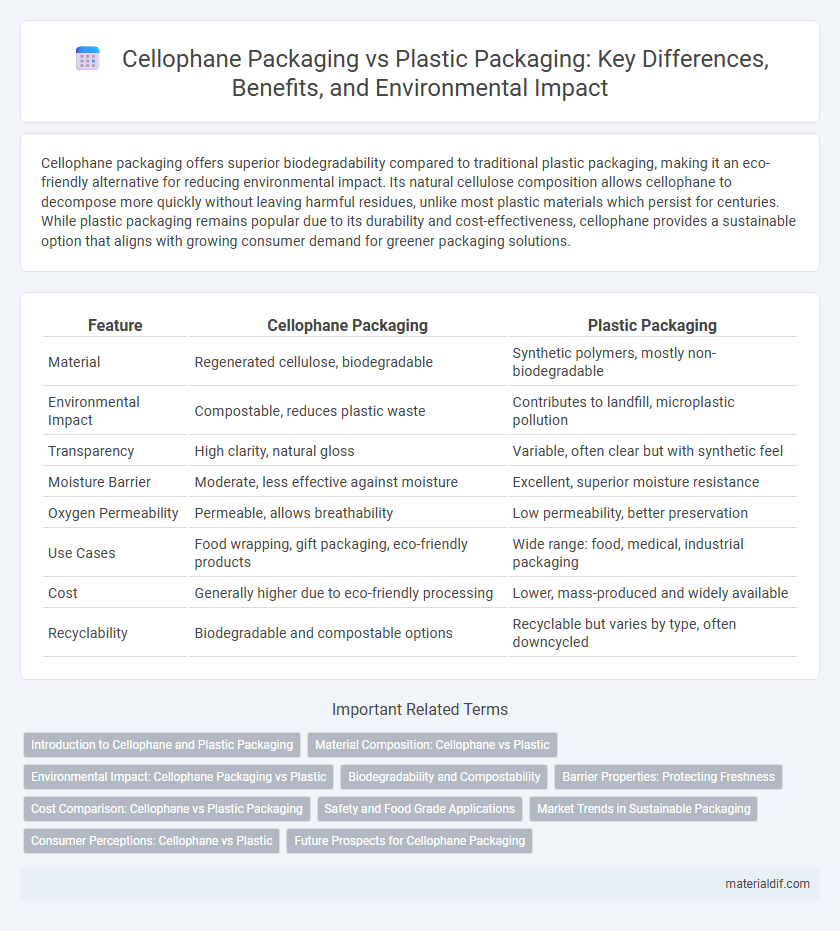Cellophane packaging offers superior biodegradability compared to traditional plastic packaging, making it an eco-friendly alternative for reducing environmental impact. Its natural cellulose composition allows cellophane to decompose more quickly without leaving harmful residues, unlike most plastic materials which persist for centuries. While plastic packaging remains popular due to its durability and cost-effectiveness, cellophane provides a sustainable option that aligns with growing consumer demand for greener packaging solutions.
Table of Comparison
| Feature | Cellophane Packaging | Plastic Packaging |
|---|---|---|
| Material | Regenerated cellulose, biodegradable | Synthetic polymers, mostly non-biodegradable |
| Environmental Impact | Compostable, reduces plastic waste | Contributes to landfill, microplastic pollution |
| Transparency | High clarity, natural gloss | Variable, often clear but with synthetic feel |
| Moisture Barrier | Moderate, less effective against moisture | Excellent, superior moisture resistance |
| Oxygen Permeability | Permeable, allows breathability | Low permeability, better preservation |
| Use Cases | Food wrapping, gift packaging, eco-friendly products | Wide range: food, medical, industrial packaging |
| Cost | Generally higher due to eco-friendly processing | Lower, mass-produced and widely available |
| Recyclability | Biodegradable and compostable options | Recyclable but varies by type, often downcycled |
Introduction to Cellophane and Plastic Packaging
Cellophane packaging, made from regenerated cellulose, offers excellent biodegradability and breathability, making it ideal for food preservation and eco-friendly applications. Plastic packaging, primarily composed of synthetic polymers like polyethylene and polypropylene, provides superior durability, moisture resistance, and cost-effectiveness widely used in various industries. The distinct material properties of cellophane and plastic influence their environmental impact, performance, and suitability across packaging needs.
Material Composition: Cellophane vs Plastic
Cellophane packaging is made from regenerated cellulose, a natural polymer derived from wood pulp or cotton fibers, making it biodegradable and compostable. In contrast, plastic packaging is typically composed of synthetic polymers like polyethylene or polypropylene, derived from petrochemicals, which are non-biodegradable and contribute to long-term environmental pollution. The cellulose structure in cellophane allows for breathability and moisture resistance, whereas plastic materials offer higher durability and water impermeability but pose greater ecological challenges.
Environmental Impact: Cellophane Packaging vs Plastic
Cellophane packaging, made from cellulose derived from wood pulp, is biodegradable and compostable, significantly reducing environmental pollution compared to plastic packaging, which relies on petrochemicals and can persist in ecosystems for hundreds of years. Unlike plastic, cellophane decomposes naturally within weeks under composting conditions, minimizing landfill accumulation and marine pollution. Despite cellophane's advantages in reducing carbon footprint and toxic waste, its moisture resistance and durability are lower than plastics, influencing its suitability depending on packaging needs.
Biodegradability and Compostability
Cellophane packaging, derived from natural cellulose, offers superior biodegradability and compostability compared to conventional plastic packaging made from petrochemicals. While plastic packaging can persist in the environment for hundreds of years, cellophane breaks down fully within weeks in composting conditions, reducing landfill waste and environmental impact. The ability of cellophane to decompose into non-toxic components makes it a sustainable alternative in packaging applications where eco-friendly disposal is prioritized.
Barrier Properties: Protecting Freshness
Cellophane packaging offers superior moisture and oxygen barrier properties compared to conventional plastic packaging, effectively preserving product freshness and extending shelf life. Its natural cellulose structure allows for breathability, preventing condensation while maintaining protection against external contaminants. Unlike many plastics, cellophane is biodegradable and compostable, providing an eco-friendly solution without compromising barrier performance.
Cost Comparison: Cellophane vs Plastic Packaging
Cellophane packaging generally incurs higher production costs compared to conventional plastic packaging, primarily due to its natural cellulose extraction and biodegradability processing. Plastic packaging benefits from lower material and manufacturing expenses, driven by petrochemical sources and established mass production techniques. Despite the initial cost difference, cellophane offers potential long-term savings by reducing environmental impact fees and appealing to eco-conscious consumers.
Safety and Food Grade Applications
Cellophane packaging is derived from cellulose, making it biodegradable, non-toxic, and safe for direct food contact, whereas plastic packaging often contains synthetic chemicals and additives that may pose health risks. Cellophane's excellent gas permeability allows fresh produce to breathe, reducing spoilage and enhancing food safety compared to impermeable plastic films. Regulatory bodies like the FDA approve food-grade cellophane for packaging fresh and processed foods, ensuring compliance with stringent safety standards.
Market Trends in Sustainable Packaging
Cellophane packaging is gaining traction in the sustainable packaging market due to its biodegradable and compostable properties, contrasting with traditional plastic packaging made from non-renewable petroleum-based materials. Market trends reveal a growing consumer preference for eco-friendly alternatives, driving increased adoption of cellophane in food and retail sectors aiming to reduce environmental footprint. Regulatory pressures and corporate sustainability goals further accelerate the shift towards cellophane packaging as a viable green solution over conventional plastic.
Consumer Perceptions: Cellophane vs Plastic
Consumers often perceive cellophane packaging as more environmentally friendly and biodegradable compared to plastic packaging, which is associated with pollution and long-term waste. The transparency and natural feel of cellophane enhance product appeal by suggesting freshness and eco-consciousness. Plastic packaging, while seen as durable and versatile, frequently faces criticism for its negative environmental impact and challenges in recycling.
Future Prospects for Cellophane Packaging
Cellophane packaging is gaining momentum as a sustainable alternative to plastic packaging due to its biodegradability and renewable cellulose base derived from wood pulp. Innovations in water-resistant and heat-sealable cellophane films are expanding its applications in food and retail packaging, addressing key preservation challenges. Market forecasts predict a steady rise in demand for eco-friendly packaging, positioning cellophane as a viable growth segment aligned with global environmental regulations and consumer preferences for green products.
Cellophane Packaging vs Plastic Packaging Infographic

 materialdif.com
materialdif.com